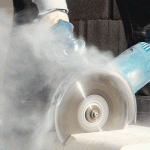At Tulsa Welding School, located in North Houston, test pieces for student use are cut using a plasma cutting system. These test pieces are 3” x 6” and are cut all day during two shifts from 8 AM to 11 PM. Because of the high use of cutting, the plasma cutting room is very dirty… Learn More
What are Mist Collectors?
Mist collectors filter the air in machine shops in order to remove harmful oil mist from CNC machines, milling and grinding processes. These systems are commonly used for CNC machine shops to eliminate oil mist. However, they can also be used to collect and filter systems with coolant mist, water mist or other oil mist…. Learn More
Respirable Crystalline Silica – OSHA PEL
The new OSHA standard for respirable crystalline silica enforcement for the general industry and maritime industry began Saturday, June 23, 20181. However, OSHA has granted a 30 day grace period for employers making an effort to meet compliance1. OSHA is offering free compliance assistance in order to help companies meet the new standard of permissible… Learn More
Beryllium OSHA Standard Revisions
OSHA published a notice of proposed rule-making on June 1st to notify the general public about an update to beryllium standard to help provide clarification and simplify compliance1. The proposed rule-making is clarifying important definitions of trace amounts of beryllium, beryllium workspace, beryllium contamination, and dermal contact. On January 9, 2017 OSHA updated the beryllium… Learn More
What is a fume extractor?
A fume extractor is a system utilizing a fan to pull fumes and particulate into a filtration system cleaning the air of harmful chemicals and particulates. Industrial processes create fumes or particles such as welding, sanding, grinding, spraying, powder filling, and chemical applications. Fume extractors use a variety of filters while some systems, depending upon… Learn More
What is USP 800?
Is your pharmaceutical compounding facility ready for USP 800? The USP 800 is a newly implemented regulation designed to promote patient health, worker safety, and address environment concerns. USP 800 applies to all pharmacies, hospitals, patient treatment centers, patient treatment clinics, physician practice facilities, surgical centers, veterinarians, home health centers, and skilled nursing facilities that… Learn More
Dangers and Side Effects of Breathing Volcanic Ash
Yesterday, Thursday May 17, 2018, at approximately 1 PM ET/5 AM HST (Hawaiian local time) Kilauea Volcano, located on southeast Island of Hawai’i near Pāhoa, erupted for the first time since 19241. This presumed phreatic eruption has sent ash plumes as far as 12 miles away2, however the actual particulate distance is difficult to measure… Learn More
Respiratory hazards of wildfire smoke
The recent and tragic wildfires in northern California have prompted many to question the respiratory hazards that are being generated due to the pungent smoke and particulate blowing off of these fires. The smoke that is produced during these fires contains a mixture of gases and fine particulates that is generated from organic plant material…. Learn More
Mesothelioma And The Hazards of Airborne Asbestos Particles
Mesothelioma is a particularly aggressive and dangerous form of cancer that manifests in the interior lung lining of the patient. It can spread at a disturbing rate, overtaking the heart, lungs or chest unless it is met with the appropriate chemotherapy treatment. Direct contact with Asbestos is the leading cause of mesothelioma, but the particles… Learn More
Toxicity of methyl methacrylate in dentistry
Initially, denture teeth were made of ceramic material. With the advent of polymethyl methacrylate (PMMA) in the 1940s, a new material was introduced for the fabrication of denture teeth. Denture teeth are currently made of either methacrylate-based resins (acrylic resin) or ceramics. Loss of teeth, which may be due to trauma, dental diseases, pathology, or… Learn More

 Made in the USA
Made in the USA
